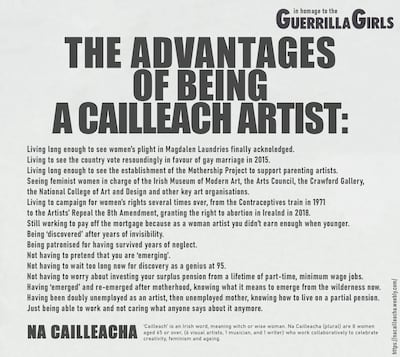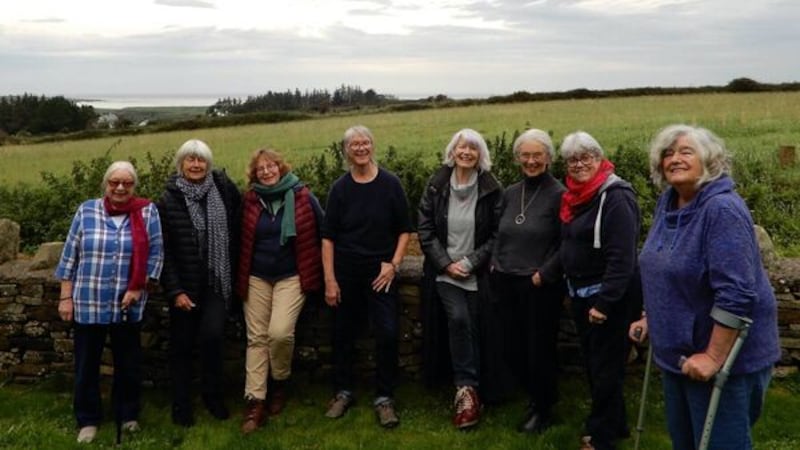
Cailleach is an Irish word meaning witch, divine hag or wise woman. The word, in all of its Celtic wisdom, was adopted by a collective of artists in 2020 who honour their creativity as Na Cailleacha, wise women, and have held numerous exhibitions around Ireland since their inception.
The group is made up of six visual artists, a jazz musician and a curator/writer who have come together to explore being female, older and, as they say, hopefully wiser.
All of the female artists, bar one, are over 70. With an exhibition currently running in The Dock Arts Centre in Carrick on Shannon, the collective explore “what it means to be women who are getting older and arguably becoming invisible” and what strategies can be devised to overcome the challenges of sustaining creativity and art practice as the seasons of life change.
Catherine Marshall is a curator and art writer, based in Dublin and Co Kilkenny. She has made artwork with the group and she is very much inspired by curatorial practice and critical theory. “In particular, it is political,” she says, “and I like to address feminism and women’s issues.”
RM Block

For example, in 2021 Na Cailleacha held an internet discussion with the Guerrilla Girls (an anonymous group of artists formed in New York in 1985 to fight sexism and racism within the art world) and marked their ongoing support with a version of their landmark 1988 poster.
“My current work, entitled Trousseau at The Dock,” says Marshall, “is part of the exhibition, Na Cailleacha, with reference to Paula Rego. It is an installation work based on old-fashioned notions of preparation for marriage but, in contrast to the fairytale narratives of love and romance, it comments on other things that can emerge as a result of religious and social practices, all of which disadvantage women.”
Marshall was invited to join Na Cailleacha in the early stages of its development by the founders – Helen Comerford, Patricia Hurl and Therry Rudin. “The four of us grew the group to what it is now and set about making it into a collective with a vision and a mission,” she says. “The themes we prioritised were feminism, ageing and creativity, all of which excited me as I had been working on attitudes to ageing prior to and during the Covid pandemic. From the outset we embraced the ideas of ageing and the body, exemplified by our choice of our name – witches in English – which is associated with the loss of youth and beauty but also with the acquisition of wisdom.”
[ Coy goddesses begone: a new wave of art reframes women’s bodies and experiencesOpens in new window ]
The collective embraced these ideas further by developing a body of work called The Age of Reason/Unreason. This exhibition alluded to the production of rational and irrational natures in the creative process with the challenges of ageing. Aiming to highlight “the freedom and importance of play”, Marshall notes that it is “also to say very directly that even if we become senile with age, we can still be creative. For that reason, we made a series of life-sized rag dolls which we presented as alter egos for ourselves, the feminist agitator (mine), the eternal mother earth figure, the warrior woman, the calming-meditating presence and so on.”
For the current show in The Dock, in her role as curator for the collective, Marshall suggested Na Cailleacha create an homage to Paula Rego, as an older woman artist whose practice touched many of the issues and practices the collective specialises in. “Under the umbrella of Paula Rego and the kind of studio practice she had, we were able to enable a film-maker, a painter, a sculptor, a feminist, a digital video artist, a composer and an abstract artist who engaged with the spirit of Rego’s work,” says Marshall. “In other words, my curatorial practice with Na Cailleacha was to create a forum that embodied the vision of Na Cailleacha but allowed for eight artists to work independently and freely within their own chosen medium and disciplines without compromising their individuality.”
Carole Nelson is a composer and musician who works primarily in jazz and improvised music, as a performing/recording artist and in collaboration with film-makers, dancers and other art forms. “My most recent work is with the Carole Nelson Trio, with whom I have recorded three albums,” she says, highlighting that she is currently collaborating with film-maker Barbara Freeman. “I was invited to join Na Cailleacha early in 2020 when it was clear that all live performance was cancelled due to the pandemic. I felt the possibility of new windows opening up rather than the closing down of my life. I was happy to step into a new and unknown world with an open heart and mind.”
[ Sean Scully in New York and Art and Soul in CorkOpens in new window ]
Exploring attitudes to ageing, their bodies, their place in the art world, and how they relate to a different culture and heritage are the all-embracing themes and ethos of Na Cailleacha. “Some of our collective work, in particular the Doll Project, has played with these ideas,” says Nelson, “particularly around the idea of play and second childhood.” While Nelson’s own music composition doesn’t necessarily explore these themes, her predominant interest is in the current ecological crisis. “My recent recordings engage with nature and our place as humans in the world.”
Barbara Freeman, a new media artist based in Belfast, previously collaborated with composers and musicians mostly on installation works and was delighted to be asked to join Na Cailleacha. “My experience of collaborations is that the process takes you somewhere else, somewhere you would not normally go,” she says. “At my age that offered excitement and the courage to develop new ways of working and also to have new ways of showing the work.”

The video Seven Voices was Freeman’s first work for the Na Cailleacha project, fusing images of the collective’s ageing skin and the stone surfaces of the landscape with sounds of the piano and saxophone by Carole Nelson. “We worked again on another video called ‘Ithaca’ which was shown at the Dock,” she says. “There were other works using new processes for me. Not only have I discovered new processes and materials but also challenges to my imagination. At 86 years, that seems good.”
Through painting, drawing, film and performance, Na Cailleacha continue to explore the nuanced progressions of growing older while combining their craft to discover and transform issues surrounding creativity, visibility, isolation and health. As a collective, they value and explore these themes from that unique older feminist perspective.











